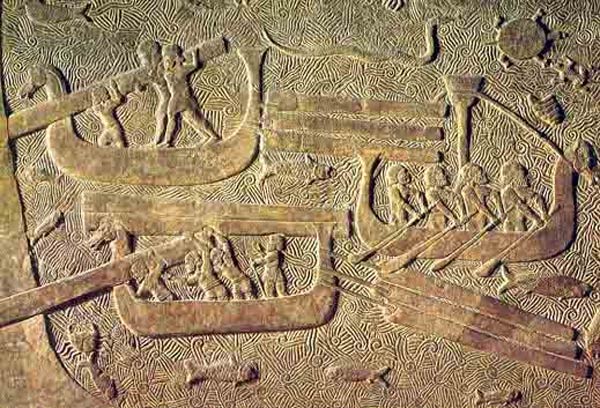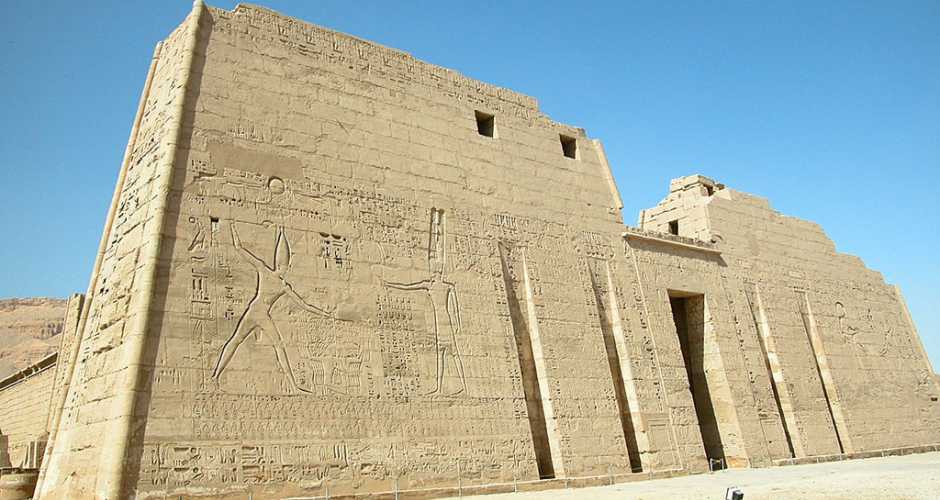by Andrew Rattray
If you’re anything like me, you love a good mystery.
The provenance of the Sea Peoples is one enduring enigma that still hasn’t been answered. You see, accounts from the 12th Century BCE describe massive armies who terrorised the Eastern Mediterranean by sea. In fact, these armies have been argued to be one of the major causes of the Late Bronze Age Collapse, a period of destabilization during the early part of the 12th Century BCE, which saw the destruction of empires and civilisations all across the region. No primary accounts detail the origin of these people, and today contemporary scholars are still unsure of exactly where they came from.
While the ultimate cause of the Bronze Age Collapse is highly contested, the devastation these people wrought is hard to overstate, and impossible to deny. One foreboding inscription from the second pylon of Medinet Habu, a Temple devoted to the life of Ramses III of Egypt reads:
“All at once the lands were removed and scattered in the fray. No land could resist their arms, from Hatti, Kode, Carchemish, Arzawa, and Alashiya on – being cut off at one time. A camp was set up in Amurru. They desolated its people and its land was like that which had never existed. They were coming forward toward Egypt, while the flame was prepared for them.”
This wasn’t simple hyperbole to exaggerate the threat faced to the Egyptian empire either. Historian Erdal Yavuz describes in his work ‘Anatolian Civilisations’ how the Sea Peoples proved to be the death-knell for the mighty Hittite empire, a major power in the region, stating:
“A mass of attacks from [a people of unknown origin] known as ‘the Sea Peoples’ destroyed much of Asia Minor, including the Hittite State, about 1200 BCE and, after that, the Hittites were never able to restore their state again.”.
These were people with enough power to topple well-established power structures, which would imply sophisticated organisation and military prowess, but who were they? The term ‘Sea Peoples’ was actually first coined by Emmanuel de Rouge in 1855 in his work ‘Note on Some Hieroglyphic Texts Recently Published by Mr. Greene’, wherein de Rouge interprets some of the imagery from the Second Pylon of Medinet Habu. The reliefs depict various battles between Egyptian forces and these unknown invaders. In fact, most of the historical records of the Sea Peoples come from Egyptian sources.
These sources, primarily detailing the lives and achievements of some of the New Kingdom Pharaohs such as Ramses the Great, Merentaph, and Ramses III, all describe the Sea Peoples as a terrifying enemy, yet they are remarkably light on details regarding their origins. Like any good mystery, however, there are some clues in the historical record for modern historians to investigate. For example, inscriptions detailing the reign of Merenptah, son and successor of Ramses the Great, describe the Sea Peoples as coming from seas to the North. This has allowed historians to rule out much of Northern Africa as their homeland, for example. Clues such as these have given way to multiple theories on the ultimate origins of the Sea Peoples.
So why are the origins of these tribes not mentioned in any records? Well the reliefs of Medinet Habu do name several tribes that fall under the general definition of ‘Sea Peoples’ including; the Denyen, the Ekwesh, the Lukka, the Peleset, the Shekelesh, the Sherden, the Teresh, the Tjeker, and the Weshesh. The problem, though, is that although they are named, their origins are not explained. The origins of some of these groups have been considered by examining other tablets and reliefs where the Egyptians named the homeland of these peoples and adding all the evidence together. In this way, modern historians have argued that the Peleset, for example, are the Philistines, originating from what is modern day Palestine.
Of course, it’s important to note that not all of the origins of all of these groups have been settled. Furthermore, while the above list, when read together, gives the impression of this being a confederation of multiple different peoples from different regions the truth is that the inscriptions do not list all nine of these peoples together in the same army at the same time. The different tribes making up the Sea Peoples ravaged the region, and Egypt in particular, multiple times over a span of decades during the reigns of Ramses the Great, Merenptah, and Ramses III.
Interestingly, some modern historians, such as Raffaele D’Amato and Andrea Salimbeti, believe that the Egyptians did know the origins of the Sea Peoples. They argue that the lack of references in any of the Egyptian reliefs or inscriptions indicate that the knowledge was so obvious as to be unnecessary to remark on. They believe that had their origins been unknown to the Egyptians, this would have been alluded to. Whether the knowledge is simply lost, or never known to begin with, the outcome is the same for us today; we do not know where they came from.
Not only are their origins uncertain, but even the nature of their arrival in the region is one that remains in debate today. De Rouge’s initial interpretations and considerations on the Sea Peoples were later expanded by Gaston Maspero in his work ‘The Struggle of the Nations’ in 1896 whereby he theorised the idea of a migratory wave of peoples that swept across the region, with various tribes joining the confederation, to ultimately form the massive armies as seen in the various Egyptian reliefs and inscriptions. This migratory theory is supported by some modern historians such as Eric Cline who has argued that factors such as climatic changes, famine, and others were what drove these migratory activities and forced the Sea Peoples to try and settle new land elsewhere.
The idea of migrations seems obvious when you look at some of the imagery that depict carts laden with women and children alongside invading forces. Indeed, this narrative of migrations became the predominant theory on the subject and has only recently faced more intense challenges from historians. For example, American historian Robert Drews in his book ‘The End of the Bronze Age’ disputes the idea of migration claiming that there are no references to such movements of people within any of the Egyptian sources and arguing that the migration theory is simply conjecture.
In its place Drews puts forward the argument that rather than migrating forces the Sea Peoples were more likely to have been pirates and raiders, arising from various locations across the Mediterranean. Drews forwards the point that the massive amounts of trade across the region, even from as far afield as modern day Sicily and Italy, would have driven piracy, and that furthermore the opulence of Bronze Age cities would have made the ideal prize for more ambitious raiders. Drews believes then that the Sea Peoples were confederations of a sort, but rather than desperate people looking to settle a new homeland, they were instead bands of pirates looking to haul away the treasures of these Mediterranean cities and empires.
Another idea is that the Sea Peoples did not come from strange, far away lands, but were actually mercenaries local to the region. Several reliefs (such as those in Luxor and Karnak) detailing the reign of Ramses the Great report that the vital regional trade center of Kadesh (in what is now modern day Syria) was captured by the Hittite empire and Ramses raised an army to drive them out. These records note that groups of Sea Peoples fought as mercenaries both for the Hittites and the Egyptians during the battle of Kadesh which ultimately ended in an Egyptian victory. This evidence also further undermines the idea that these were a single conglomerate of people with a unitary goal as suggested by those that champion the migratory theory.
So it seems that even after 150 years we are no closer to settling on the truth of these enigmatic people. Where did they come from? What brought them to the region? Did they truly provide the catalyst for the Late Bronze Age Collapse, as some have argued, which snuffed out so many civilisations of the Eastern Mediterranean? Ultimately, we may never know for sure.













No comments yet. You should be kind and add one!
Our apologies, you must be logged in to post a comment.